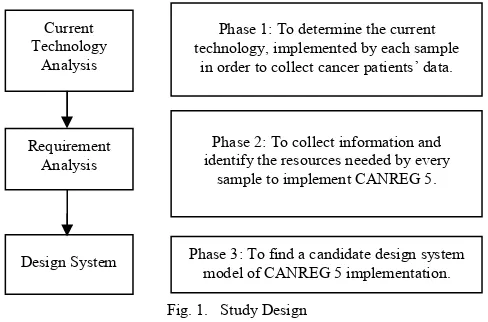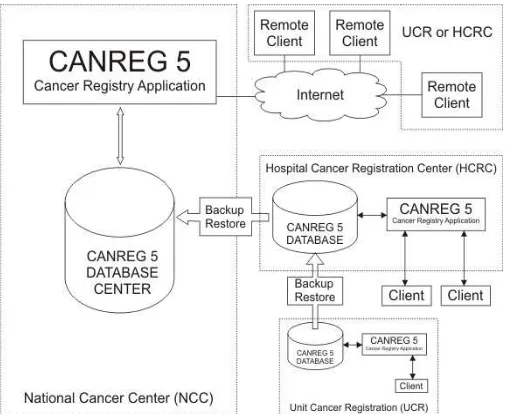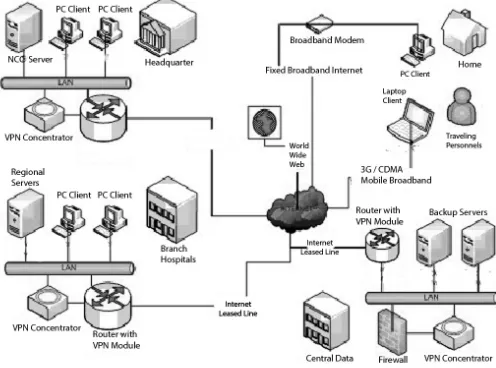CANREG 5 Networks for Indonesia
Abstract— Indonesia is searching for the suitable technology to manage cancer registration; CANREG 5 has this suitability advantage. This study's aim and result were to develop a CANREG 5 network model and to apply the model within Indonesian hospitals. The research was qualitative in nature, collecting data in the form of interviews with staff and clinicians from five teaching hospitals in different Indonesian provinces. The study found three possible network models of CANREG 5 that can be implemented in Indonesia: (1) local running network of CANREG 5, (2) fragmented network, and (3) integrated network. Each of the models can be implemented based on available information technology resources at each hospital.
Keywords— CANREG, cancer registration, networks model
I. INTRODUCTION
Based on data from the Ministry of Health of the Republic of Indonesia, 12% of the world's mortality is caused by cancer, placing the disease as the second leading cause of death after cardiovascular diseases [1]. Meanwhile in Indonesia, the prevalence of tumor/cancer is 4.3 for every 1,000 persons. Cancer is the seventh leading cause of death (5.7%) after stroke, tuberculosis, hypertension, and perinatal causes. The high rate of mortality in cancer patients is primarily due to the late start of treatment i.e., during the final stage of the cancer; thus, this rate can be minimized through early detection. Numerous countries have a National Cancer Control Program that aims to reduce the number of cancer cases and deaths then subsequently improve the quality of life of the patients. One of the most important activities of this type of center is cancer registration.
One of the forms of assistance that World Health Organization (WHO) provides to nations for implementing cancer registration ið?Y@ANREG. Through the
application of this software, WHO hopes that cancer registration would be established in every nation. However, the technological differences within each nation and its region prevents this software from being instantaneously universal in its application. Usually some modifications are required prior to implementation, especially with regards to the type and content of data variables to collected and recorded. Indonesia was one of the nations with such modified version of the software, called SRIKANDI (Cancer Registration System in Indonesia); it was a modified version of CANREG 4.
Currently, WHO is in the midst of launching CANREG version 5 with improvements that may provide additional benefits to the efforts to implement cancer registration in
Indonesia. With this rationale, the study reviewed how to apply CANREG 5 for Indonesia with a particular focus on developing a computer network model for adapting CANREG 5. The study sample consists of five cancer/oncology hospitals in different provinces within Indonesia.
II. CANCER REGISTRATION
The main objective of a cancer registry is to collect and classify information on all cancer cases then produce statistics on the occurrence of cancer within a defined population. These data would serve as framework for assessing and controlling the impact of cancer on the community [2]. These registries contain cancer patients' information along with their diseases' clinical and pathological characteristics. Each data entry point is collected periodically and systematically from various sources [3]. All data are then analyzed to provide information on incidence and characteristics of specific cancer types within a specific setting, such as a geographical region or a cancer hospital. Cancer registration can also be used for monitoring occupational groups and cohorts of at-risk individuals who are exposed to various carcinogens on a regular basis. The registry can also serve as a convenient source of study participants for clinical and epidemiological studies [3]. Additionally, having a functional cancer registration system enhances a hospital's ability to provide care for cancer patients by assisting the medical staff with tracking their cases' follow-ups then providing statistical data on therapy results. The latter allows for clinicians to improve their practice, providing feedback on the efficacy of cancer management regiment that they have prescribed.
III. CANCER REGISTRATION IN INDONESIA
Cancer registration in Indonesia has been in development for several decades. The first population-based Cancer Registration in Indonesia was established in Semarang, Central Java in 1970. Since 1987, the implementation of pathology-based Cancer Registration in Indonesia has been developed for 13 areas, involving 64 branches of IICPA Pathology Laboratory in the cities of Medan, Padang, Palembang, Bandung, Semarang, Surakarta, Yogyakarta, Surabaya, Malang, Denpasar, Ujung Pandang, Manado and Jakarta; these cities are located in several different provinces. In November 2008, a new regulation No. 1068/Menkes/SK/XI/2008 was issued for the Implementation of Population-Based Cancer Registration in Indonesia. Jakarta was chosen as the site of the pilot project, which involved forty hospitals.
IV. COMPUTERIZED CANCER REGISTRATION
The development of Information Telecommunication and Technology (ICT) has influenced the cancer registration process. ICT eases the management cancer patients’ data, including the storage, verification and analysis of the data. International Agency for Research on Cancer (IARC) of WHO developed the CANREG software as a part of the effort to help nations implement their own cancer registration.
A. CANREG Version
The first CANREG version was developed by Allen Bieber in DOS mode [4] with influences from the computer's Operating System. Additionally, CANREG was developed to fit the classification systems to code the topography, morphology, and behavior of cancer [5]. The development also pointed to the easiness of software implementation. Table 1 shows CANREG versions that have existed and their developers.
TABLE I. CANREGVERSION
CANREG Version Developer
CANREG 1 Allen Bieber
CANREG 2 Stéphane Olivier
CANREG 3 and 4 Andy Cooke
CANREG 5 M. J. Ervik
B. CANREG 5 Features
CANREG 5 is an open source tool to input, store, verify, and analyze cancer registry data [6]. This software can be used to input cancer patients’ data, validate the data, and assist clinicians in data analysis. Main improvements from the previous version include the new database engine, improved multi-user capacities, and the open-source nature of the project's management [6]. The advantage of CANREG 5 is its ability to facilitate the set-up of a new database or one based on the modification of an existing database through the addition of new variables and the customization of the data entry forms [6]. This module allows each country to choose and define variables based on a set of characteristics specific to the country.
CANREG 5 software is designed for users with limited budget and minimal computing skills. It is also used only for relatively small data sets [7]. This software is aimed towards developing countries with no cancer registration system. The advantages of CANREG 5 are as follows [7]:
1) It can be customized to store data variables that have been defined by the user;
2) Language on the menu can be customized based on the country using the software;
3) It has the ability to check for any data duplication;
4) It possesses an automatic system back-up and data
tools to perform analysis consisting of R, SOFA, SPSS, etc. Another advantage is that CANREG 5 can also be run locally (stand-alone) or in a computer network (client-server) [6]. These features provide every cancer hospital the convenience in implementing CANREG 5.
V. METHODOLOGY
This study was conducted using a qualitative research method that was categorized as non-experimental research. Five cancer hospitals were chosen as samples for the study. All samples were teaching hospitals in Indonesia. Four of the five hospitals are members of the Nationwide University Network of Indonesia (NUNI). Nationwide University Network of Indonesia (NUNI) is a strategic collaboration among universities in Indonesia with the objective of creating value in academic excellence through mobility of research, faculty, and student. NUNI was declared and established on October 21, 2011 through the Transnational of Higher Education Summit (THES) event by its 21 members of Indonesian universities. The Director of Institutional Affairs and Cooperation – the Directorate General of Higher Education, and all participants THES (including industries and universities) witnessed the signing of the NUNI Declaration.
This study aimed to analyze requirements necessary for operating the cancer registration using the CANREG 5 software in Indonesia, either locally or in a network. The requirement analysis results were used to build a possible design system model to implement CANREG 5 for Indonesia. Figure 1 shows the study design for this research.
Fig. 1. Study Design
VI. RESULT AND DISCUSSION
A. Current Technology Analysis
All hospitals in the sample already have a pre-existing system to record cancer patient data, be it paper-based or computer-based. However, the recording is still done by each unit/division with no integration among the systems. For computer-based registration, most hospital units recorded their
Current Technology
Analysis
Requirement Analysis
Design System
Phase 1: To determine the current technology, implemented by each sample
in order to collect cancer patients’ data.
Phase 2: To collect information and identify the resources needed by every
sample to implement CANREG 5.
entry and management. The databases were also difficult to maintain and verify. Moreover, the process of data analysis was cumbersome and inefficient.
SRIKANDI is a modified version of CANREG 4. The advantages of SRIKANDI are as follows [7]:
1) CANREG 4 can be tailored to the needs of a cancer hospital;
2) Easy to operate using the Indonesian language;
3) Recording patient information in accordance with the address of the structure in Indonesian territory;
4) Relatively more rapid response when modifications to the program are required.
On the other hand, the weaknesses of the application are as follows [7]:
1) Lack of search ability to find data duplication events; 2) The absence of security systems necessary to prevent
access of the data by unauthorized persons;
3) Lack of features for automatic data verification process; 4) The process of data transfer between units or hospitals to
the cancer data center is still done manually, sending encrypted data through email;
5) The absence of automatic data back-up process to prevent data damage ;
6) The absence of a warning system for cancer patients who need follow-ups;
7) Lack of features to perform analysis on cancer patient data that has been stored in the database.
Major problems found in the cancer registration process are the lack of data verification and database integration among the hospital units. The existing software also did not support automatic data back-up. From the outcome of site visitations, almost all hospitals have sufficient resources in terms of computers and computer networks. rendering it possible to run CANREG 5 as cancer registration software locally or in a network.
B. Requirement Analysis
CANREG 5 is an open source program developed using the Java language, rendering the need for Java 7 Runtime Environment (JRE) to run it [6]. Complete requirements for running JRE are listed in Table 2.
By default, most Java Virtual Machine (JVM) implementations limit themselves to using a small amount of RAM (e.g. 64 MB), even if the computer has a much larger system RAM (e.g. 1 GB) [6]. This situation can lead to out of memory conditions, even if the computer has lots of free memory. This issues can be solved by configuring Java Running Parameters to Xmx256M-Xms256M-Xss128k [6]. Thus, with this setting, CANREG 5 should ideally run in a computer with a RAM greater than 256 MB.
TABLE II. JREREQUIREMENTS [8]
Platform Operating System Hardware Spec.
WINDOW Windows Server 2008 Windows Server 2012 (64-bit)
RAM: 128 MB, 64
Red Hat Enterprise Linux 5.5+, 6.x (32-bit), 6.x (64-bit) Ubuntu Linux 10.04 and above Suse Linux Enterprise Server
10 SP2, 11.x
RAM: 64 MB Disk space: 58 MB
CANREG 5 requires a third-party tool to perform analysis. Some of the more advanced analytical features in CANREG 5 rely on the free software for statistical computing and graphics, R, which compiles and runs on a wide variety of UNIX platforms, Windows, and Mac OS [6].
CANREG 5 can operate locally or in a network. Utilization of these applications locally is supported by back-up and restore features that allow hospitals without an integrated computer network to collect and update their data from all units. More specifically, each unit performs its own back-up of patients data then relays the back-up information to the hospital's cancer registration center. Additionally, the back-up data from each unit can be restored by the cancer registration center; this process requires unique patient identification numbers to avoid data duplication and replacement. Thus, to run CANREG 5 in a hospital's computer network, each unit needs its own server in the cancer registration center and client computers. The servers should have enough hardware and computer network resource to capture all data transaction from clients, requiring a model with consistent and reliable network based on IP (Internet Protocol).
CANREG 5 has the feature for modifying the variables to be recorded in the database through the use of a built-in editor. This is an especially useful feature because collected variables ought to be defined based on the needs and purpose of a specific hospital and its individual clinicians. These variables should be declared in the Data Dictionary (DD) and be based on collected samples. Figure 2 shows the database structure of CANREG 5 for Indonesia.. There were 54 variables proposed by the clinicians from the five hospitals in the study's site samples.
Fig. 2. CANREG 5 Database Structure
1) Unit Cancer Registration (UCR) to perform data entry for patients in a unit and capture all of variables that declared in CANREG 5.
2) Hospital Cancer Registration Center (HCRC) to collect all recorded data from every unit and validate all collected data. Every province in Indonesia should have one HCRC.
3) National Cancer Center (NCC) to store all collected data for Indonesia. This NCC would collect data from every HCRC in Indonesia.
C. Design System
Based on the requirement analysis, there are 3 possible models that can be used to implement CANREG 5 as a cancer registration software in Indonesia: locally run network (stand-alone), fragmented network, and integrated network. Figure 3 illustrates the technical architecture of CANREG 5 for the Indonesian Cancer Registry Database Application.
1) Locally-Run CANREG 5
This is possible due to CANREG 5's design that enables its usage in hospitals with limited computer and network support. Every UCR requires only a data entry staff and a personal computer to run CANREG 5. After the data entry process, each UCR sends its back-up file database periodically to the HCRC. The HCRC then restores and compiles the back-up database from every UCR into a single database. After HCRC has created its database, it would then back-up and send the file to the NCC. Figure 4 shows the architectural model for running CANREG 5 locally.
Fig. 4. Architectural Model for Running CANREG 5 Locally
2) Running CANREG 5 in a Network a. Fragmented Network
b. Integrated Network
The model for running CANREG 5 in an integrated network is suitable for a hospital supported with both an integrated LAN and an internet connection. The UCR is connected to the NCC database server through the internet network. Figure 6 shows the architectural model for running CANREG 5 in an integrated network.
Fig. 6. Architectural Model for Running CANREG 5 in An Integrated Network
The integrated network model, however, may pose an issue in internet security. Jonathan, Pardamean, and Suzanna (2011) propose an integrated network model using Virtual Private Network (VPN). VPNs have encryption and authentication techniques that would protect the data transfer through a private internet system [9]. Figure 7 shows the proposed network architecture of CANREG 5 using VPN.
Fig. 7. Proposed Network Architecture of CANREG 5 [9]
VII.CONCLUSION
All cancer patients should be recorded in a database to assist in a hospital's ability to treat its patients as well as to improve the quality of its care. These technological assistance can range from coordinating follow-up visitations for clinicians' cases to providing statistical data on the prescribed treatment results. The maintenance of the database should be as simple as possible. Information Technology (IT) can be applied to in the data recording processes. Software, hardware, and computer network can be optimally used to support the data registration process.
CANREG 5, as an open source cancer registration software, was created to assist hospitals in recording and analyzing data. This software can be used in a variety of IT resources, regardless of the extent of its IT support. Furthermore, the variables of the software that record the database can be modified easily through its built-in editor.
Three network models are proposed for Indonesia's implementation of the software: (1) running CANREG 5 using a local setup, (2) fragmented network, and (3) integrated network. The first model is especially useful for hospitals with limited network support. Other hospitals with more advanced and adequate network supports can utilize the two latter models.
REFERENCES
[1] Kementerian Kesehatan Republik Indonesia, 2011. [Online]. Available: http://www.depkes.go.id/index.php/berita/press-release.
[2] Jensen, O. M. and Storm, H. H., "Purposes of Cancer Registration," in Cancer Registration: Principles and Methods, O. Jensen, D. Parkin, R. MacLennan, C. Muir and R. Skeet, Eds., Lyon: IARC Scientific Publication, 1991.
[3] Shanmugaratnam, K., "Introduction," in Cancer Registration: Principles and Methods, O. Jensen, D. Parkin, R. MacLennan, C. Muir and R. Skeet, Eds., Lyon: IARC Scientific Publication, 1991.
[4] Coleman, M. P. and Bieber, C. A., "CANREG: Cancer registration software for Microcomputer," in Cancer Registration: Principles and Methods, O. Jensen, D. Parkin, R. MacLennan, C. Muir and R. Skeet, Eds., Lyon: IARC Scientific Publication, 1991.
[5] Ferlay J., Burkhard C., Whelan S. and Parkin D., "Check and Coversion Programs for Cancer Registries (IARC/IACR Tolls for Cancer Registries)," IARC Technical Report No. 42, Lyon, 2005.
[6] Ervik M. J., CANREG 5-Instructions, Lyon: International Agency for Research on Cancer, 2013.
[7] Godjali D. D., Pardamean B. and Suzanna E., "Pengembangan Sistem Registrasi Kanker Indonesia," Indonesian Journal of Cancer, vol. 6, no. 2, pp. 61-66, 2012.
[8] Java, "What are the system requirements for Java 7?," ORACLE, [Online]. Available: http://www.java.com/en/download/help/sysreq.xml. [Accessed 27 11 2013].


